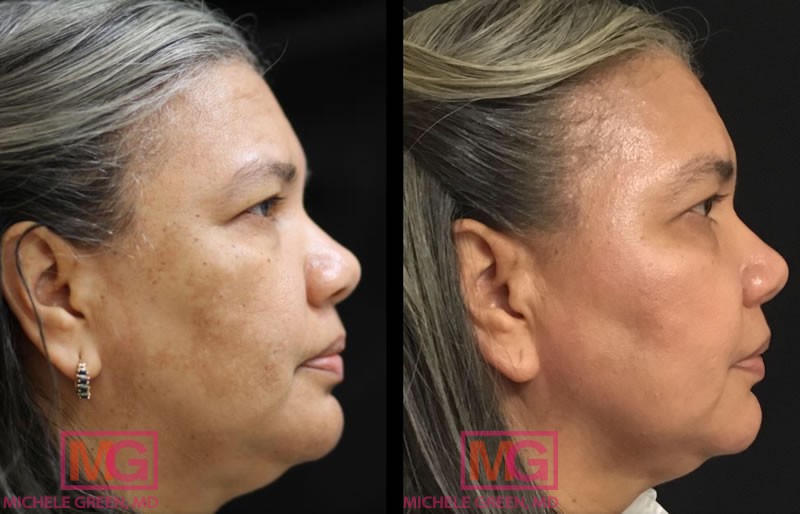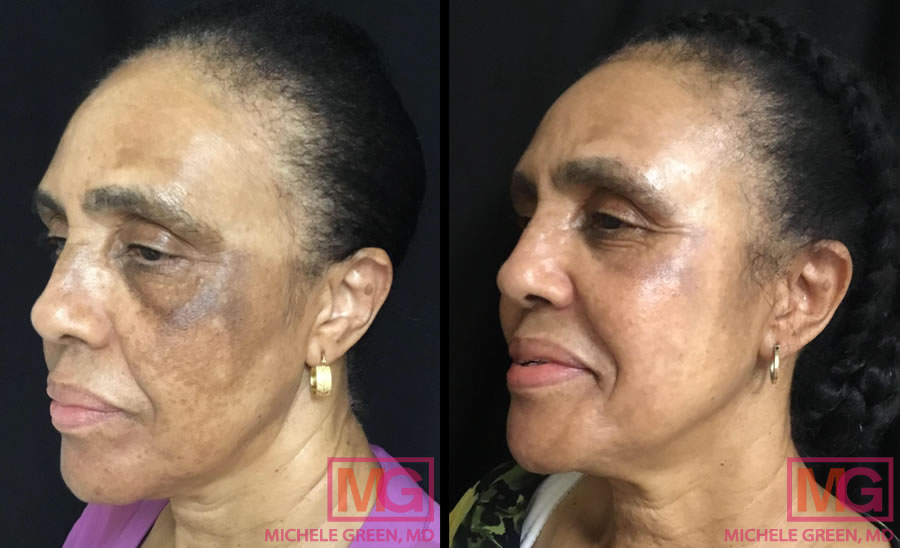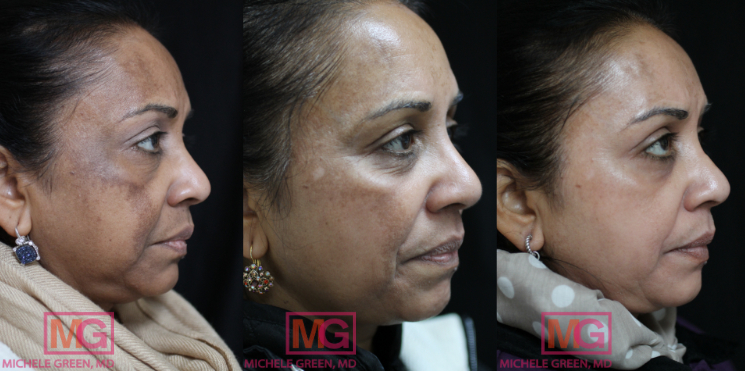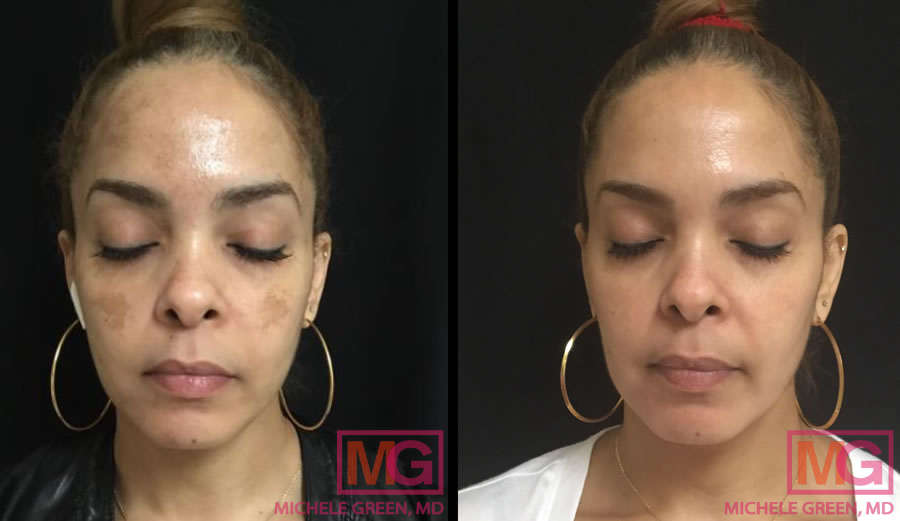Tri-Luma Cream for Melasma
Melasma is a common skin condition, with more than 5 million people affected and 200,000 new cases every year. Characterized by uneven brown or gray dark spots appearing on the skin’s surface, melasma is notoriously difficult to treat. While the exact cause of the condition is not known, studies have shown that sun damage, unprotected exposure to UVA and UVB rays of light, and hormonal fluctuations, such as those that occur during pregnancy or while on birth control pills, considerably worsen the discoloration associated with melasma. Melasma tends to affect patients with darker skin types at a higher rate than patients with lighter skin color due to the higher concentrations of melanin and the activity of melanocytes in darker skin. Melasma cannot be completely cured, leading patients to wonder if there are methods that are effective in managing the condition and depigmenting the affected areas. Luckily, there is a prescription topical cream available at board-certified dermatologist Dr. Michele Green’s New York City office: Tri-Luma Cream for melasma.
Tri-Luma is a short-term topical prescription drug for the treatment of melasma on the face and body. Produced by the company Galderma, Tri-Luma is the only FDA-approved prescription topical cream for the treatment of moderate to severe melasma. With three active ingredients — hydroquinone 4%, Tretinoin 0.05%, and Fluocinolone acetonide 0.01% — Tri-Luma acts as a depigmenting agent to lighten the skin, improve skin cell turnover, and reduce the production of melanin. In clinical trials, Tri-Luma was demonstrated to be the most effective when combined with strict sun avoidance and protection to reduce the risk of exacerbating the skin condition. In addition to daily application of Tri-Luma for the prescribed length of time, Dr. Green recommends always wearing protective clothing and sunscreen with SPF 30 or higher whenever you go outside. For expert medical advice, schedule your initial consultation with board-certified dermatologist and Tri-Luma prescriber Dr. Michele Green.
Experienced board-certified dermatologist Dr. Michele Green has been masterfully treating patients in her Upper East Side New York City dermatology office for more than 25 years. With her proprietary range of skincare products, MGSKINLABs, Dr. Green is an expert in providing patients with individualized treatment plans tailored to their skin type and aesthetic goals. Whether you are concerned about sensitive skin, hyperpigmentation, dark spots, melasma, or signs of the natural aging process, Dr. Green has plenty of treatment options available. In addition to generating individualized skincare plans, Dr. Green has a range of in-office treatments that can help with melasma management and treatment, including chemical peels, mesopeels, microneedling, microdermabrasion, laser treatments, and Cosmelan peels. Well-known for high patient satisfaction, Dr. Green has been voted one of the best dermatologists in New York City by such publications as Castle Connolly, Super Doctors, and New York Magazine.
What is Tri-Luma?
Tri-Luma cream is the only FDA-approved topical treatment option for addressing cases of melasma, which is a skin condition characterized by the appearance of dark spots on the skin’s surface. When applied to the affected areas of the skin, Tri-Luma works as a skin lightener, reducing the appearance of discoloration and inhibiting the further production of melanin in the treated area. Tri-Luma contains three active ingredients—Hydroquinone 4%, the retinoid Tretinoin 0.05%, and the corticosteroid fluocinolone acetonide 0.01%—for controlled skin bleaching, skin cell turnover, and the prevention of inflammation. These powerful active ingredients combined into one cream make Tri-Luma one of the most effective treatment options for controlling melasma, a skin condition that is notoriously difficult to treat. Tri-Luma is only designed for short-term use—typically prescribed for a total of eight weeks.
What is Tri-Luma cream used for?
Tri-Luma is specifically designed for the treatment of moderate to severe melasma on the face and is the only FDA-approved topical melasma treatment option available (FDA.gov). While Tri-Luma is highly effective at reducing the appearance of dark spots associated with melasma, it is only designed for short-term use. Typically, your healthcare provider will prescribe Tri-Luma cream for a maximum of eight weeks, as long-term use of the cream can cause lasting damage to the body. When used as intended, Tri-Luma can reduce the discoloration associated with melasma, helping to get the condition under control. The treatment results are improved when patients avoid unprotected exposure to harmful UV rays, including those emitted by sunlamps and tanning beds.
How does Tri-Luma work?
Tri-Luma works via three active ingredients: Hydroquinone 4%, Tretinoin 0.05%, and Fluocinolone acetonide 0.01%. Hydroquinone is an ingredient commonly found in skin-bleaching or skin-lightening creams. When it is not prescribed by a dermatologist or medical professional, hydroquinone can be dangerous, particularly for patients with darker skin, causing possible side effects like permanent blue or black darkening of the skin. In prescription topical creams like Tri-Luma, however, hydroquinone is effective at reducing pigmentation in the skin. Not only does the hydroquinone act to reduce dark spots, but it also prevents the synthesis of melanin in the melanocytes to suppress further discoloration. In addition to the hydroquinone present in Tri-Luma, tretinoin is another active ingredient essential in reducing the appearance of melasma. Tretinoin is a retinoid, which is a derivative of vitamin A, that helps boost skin cell turnover. The exfoliation of discolored skin cells, along with the production of new, lighter skin, helps to reduce the appearance of dark spots on the skin’s surface. Tri-Luma also contains the corticosteroid fluocinolone acetonide. With anti-inflammatory properties, fluocinolone acetonide helps to reduce the skin irritation associated with hydroquinone and tretinoin, as well as inhibits the production of melanin in the melanocytes. All together, these three active ingredients work to reduce the signs and symptoms of melasma.
Does Tri-Luma work for melasma?
Melasma is a skin condition characterized by areas of pigmentation due to the overproduction of melanin. These blotchy gray or brown patches of discoloration appear most commonly on areas of the face, such as the upper lip, cheeks, bridge of the nose, and forehead. Melasma occurs when the pigment melanin is overproduced in the melanocytes, which are responsible for producing melanin. When melanin is overproduced, it causes uneven pigmentation across the skin’s surface, resulting in uneven dark patches. The exact cause of the skin condition is not yet known. However, several major risk factors increase the likelihood of developing melasma, including sun exposure, fluctuations in hormone levels, and skin type. Tri-Luma Cream has been FDA-approved to reduce the appearance of melasma in the skin, meaning that through several clinical trials, the topical cream was determined to be safe and effective for the treatment of melasma.
Is Tri-Luma good for melasma?
Tri-Luma is the only FDA-approved topical cream designed specifically for the treatment of moderate to severe melasma. Melasma is a skin condition that is notoriously difficult to treat and impossible to cure. The best way to control the condition is to manage the symptoms and then avoid possible triggers, including sun exposure, tanning beds, sunlamps, and hormonal birth control pills. Tri-Luma is very good for controlling melasma flare-ups in the short term, reducing the symptoms of melasma, like dark spots and skin discoloration, over eight weeks. Several clinical trials demonstrated that Tri-Luma was effective in reducing symptoms of melasma, with 77% of the patients who received Tri-Luma treatment seeing a full or near-full reduction in discoloration by week 8. Once the round of Tri-Luma is complete, patients should practice strict sun avoidance by wearing protective clothing and sunscreen with SPF 30 or higher whenever going outside.
What are the side effects of Tri-Luma?
Tri-Luma Cream is associated with several common side effects, including:
- Skin irritation and redness in 41% of treated patients
- Skin peeling or flaking in 38% of treated patients
- A burning sensation in the treated area in 18% of treated patients
- Skin dryness in 14% of treated patients
- Itching in 11% of treated patients
Patients can reduce dryness, flaking, and skin irritation by avoiding astringent products like scented soaps, exfoliating cleansers, or skin-peeling agents.
Some patients who used Tri-Luma cream for melasma also experienced side effects that included:
- Skin or hair follicle infection
- Rosacea
- Permanent blue or black darkening of the skin
- Skin thinning
- Acne breakouts
- Infection around the mouth
Tri-Luma contains a corticosteroid, fluocinolone acetonide, which can cause axis suppression—the suppression of the adrenal gland that helps regulate stress. Axis suppression can decrease the ability to fight infections. Tri-Luma cream should not be prescribed to patients with a history of severe allergic reactions to sulfites. If you are experiencing an allergic reaction to medication, seek medical attention immediately. Patients who are pregnant or breastfeeding should not be prescribed Tri-Luma, as there is the possibility of producing birth defects, especially in early pregnancy.
Can Tri-Luma make melasma worse?
Tri-Luma is FDA-approved for the short-term treatment of melasma and has been shown in clinical trials to be safe and effective for the reduction of discoloration associated with melasma. Tri-Luma is designed to supplement, not substitute, the practice of reducing exposure to melasma triggers and risk factors. Sun exposure and hormone fluctuations are two of the most common underlying triggers for melasma flare-ups. Without addressing these underlying triggers, melasma symptoms will not improve long-term, even with Tri-Luma treatment. That is why Dr. Green recommends applying sunscreen with SPF 30 or higher every morning before leaving the house and discussing with your OB-GYN to find alternative forms of birth control.

Is Tri-Luma better than hydroquinone?
Hydroquinone is a common ingredient in skin-lightening creams, as it inhibits the production of melanin in the melanocytes and helps to brighten the skin. However, hydroquinone skin-lightening products can be dangerous for long-term use, as they are associated with skin irritation and permanent skin discoloration, especially for patients with darker skin tones. Hydroquinone is only FDA-approved as an ingredient in prescription medications so that a medical professional can monitor the effects of the treatment. Hydroquinone is one of the active ingredients in Tri-Luma Cream and is found in a 4% concentration in the topical medication. When combined with other active ingredients, tretinoin, and fluocinolone acetonide, the hydroquinone in Tri-Luma is highly effective at reducing the symptoms of melasma, making it more effective than hydroquinone cream alone.
Is it better to use Tri-Luma cream than tretinoin for melasma?
Tretinoin is a retinoid, which is a vitamin A derivative, that is used to boost skin cell turnover for new skin growth. Available over the counter in low concentrations, tretinoin cream is used to treat hyperpigmentation and reduce the appearance of wrinkles on the face and body. Tretinoin is also one of the active ingredients found in Tri-Luma cream, working specifically to boost skin cell turnover for lighter, brighter skin. When treating melasma, Tri-Luma cream is typically better than using tretinoin cream in isolation, as Tri-Luma also contains the active ingredients hydroquinone and fluocinolone acetonide to inhibit melanin production, reduce inflammation, and eliminate discoloration associated with melasma.
Does Tri-Luma work for hyperpigmentation?
Tri-Luma cream is only FDA-approved for treating pigmentation and discoloration related to melasma. Hyperpigmentation can occur for a number of reasons, and the root cause of the discoloration will determine the best treatment method. Melasma is often triggered by sun exposure but is different from sun spots, which are small dark spots that form due to the overproduction of melanin when patients are exposed to the sun without protection. Sun spots, also called age spots or liver spots, can be treated using a variety of treatment options that range from laser treatments with Fraxel, Clear + Brilliant laser, Alex-TriVantage, Intense Pulsed Light (IPL), chemical peels, Cosmelan peels, to bleaching creams with hydroquinone, to microneedling with skin lightening serums, and more. Many treatments for liver spots work by removing the pigment that makes up the aged spots or by blocking the production of melanin in the pigmented area of the skin and keeping the skin light and bright. Tri-Luma, however, is not FDA-approved for treating hyperpigmentation that is not associated with melasma, meaning that it should not be used for age spots. On the flip side, many of the treatments that are safe and effective for age spots, including laser treatments, can make melasma worse. Consulting with an expert board-certified dermatologist like Dr. Michele Green can help you find the treatment option that is safe and effective for your specific skin condition.

Is Tri-Luma over the counter?
Many patients wonder, “Where to buy Tri-Luma?” Tri-Luma is not available over the counter, meaning it is only available as a prescription drug prescribed by a healthcare professional or board-certified dermatologist like Dr. Green. Tri-Luma contains a relatively high concentration of hydroquinone (4%), which can be dangerous for patients when it is not regulated and well-monitored by a medical professional. The FDA has not approved the use of over-the-counter products containing hydroquinone, as they can lead to serious adverse events like severe skin irritation and permanent discoloration. Due to the high dose of hydroquinone, Tri-Luma should only be used for eight weeks as directed by a dermatologist.
Why is Tri-Luma so expensive?
Tri-Luma is a prescription medication used short-term to control the symptoms of melasma by eliminating discoloration and reducing the production of melanin in the skin. Due to its high concentration of hydroquinone, the topical cream is only available as a prescription drug prescribed by a board-certified dermatologist like Dr. Green. Tri-Luma is the only FDA-approved topical cream for the treatment of moderate to severe melasma, meaning that no generic, over-the-counter product can be used for the same effect.
Why does Tri-Luma have to be refrigerated?
Tri-Luma should be applied to the treated area once a day and kept refrigerated when not in use. It is important to store the cream in a refrigerator set to between 36 and 46 degrees Fahrenheit and avoid freezing it. If the cream is refrigerated, it will retain its ability to treat the condition effectively.
How to apply Tri-Luma cream on the face
Tri-Luma cream should be applied to the treatment area once a day at least 30 minutes before going to bed for the prescribed amount of time—typically eight weeks. Patients should begin the application process by cleaning their face with a gentle cleanser. Be sure to avoid scented soaps or exfoliating cleansers that can irritate the skin further. After washing the face, apply the Tri-Luma cream to the affected area, extending the cream application about a half inch beyond the border of the discoloration. During application, avoid the area around the eyes. If the cream comes into contact with your eyes, be sure to rinse thoroughly. Once you have finished the application, be sure to wash your hands and avoid touching your eyes. Dryness, itching, flaking, and peeling are common side effects of Tri-Luma cream. Dr. Green recommends applying a gentle moisturizer every morning to combat these side effects.

Does Tri-Luma make your skin peel?
Tri-Luma cream is associated with common side effects, including skin peeling, dryness, irritation, redness, and burning. According to clinical trials, 38% of patients using Tri-Luma cream reported skin peeling. To combat these common side effects, Dr. Green recommends using a moisturizer or moisturizing cream to keep the skin hydrated during the day. Since Tri-Luma is applied at night—at least 30 minutes before bed—be sure to apply moisturizer in the morning after washing your face.
Does melasma come back after Tri-Luma?
Melasma is a skin condition characterized by discoloration and dark spots that appear on the face. While the exact cause of melasma is not known, the condition can be triggered by exposure to UV rays from the sun, sunlamps, or tanning beds and hormone fluctuations from pregnancy, puberty, or hormonal birth control pills. There is no cure for melasma, but the symptoms of the condition, including flare-ups of discoloration on the face, can be lessened and managed. Tri-Luma cream is highly effective at reducing the symptoms of melasma by brightening the skin and inhibiting melanin production in the melanocytes. However, Tri-Luma is only a short-term treatment option. To maintain the results of the treatment, patients will need to address the underlying triggers for the condition. Dr. Green recommends that patients practice strict sun avoidance by wearing protective clothing and sunscreen with SPF 30 or higher. If patients are on hormonal birth control pills, Dr. Green recommends discussing other alternatives with their OB-GYN.
Is Tri-Luma safe?
Tri-Luma is FDA-approved for the treatment of melasma, meaning that extensive clinical trials have demonstrated that it is safe and effective for its intended purpose. Using Tri-Luma can be associated with significant side effects, which is why it is essential to seek care from an expert dermatologist like Dr. Michele Green and disclose all relevant medical history. Patients with an allergy to sulfites should not use Tri-Luma cream. Patients who are pregnant or breastfeeding should also avoid Tri-Luma, as the cream can be associated with the development of congenital disabilities. Patients with darker skin tones are at a higher risk of developing permanent skin discoloration as a result of Tri-Luma treatment. It is also essential to apply the cream only as directed—once a day for eight weeks—as prolonged application of the cream can significantly weaken the immune system.
Why was Tri-Luma taken off the market?
Tri-Luma cream was never removed from the market, but it is only available as a prescription medication. Products containing hydroquinone, like Tri-Luma, are not available over the counter, as hydroquinone can be associated with serious side effects like permanent skin discoloration. The US Food and Drug Administration has significantly cracked down on pharmaceutical companies that are selling over-the-counter products containing hydroquinone due to the risk they pose to patients. To find out which products are safe to use for melasma, schedule a consultation with an expert dermatologist like Dr. Michele Green.
Does Tri-Luma work?
Tri-Luma is a safe and effective treatment option for reducing the symptoms of moderate to severe melasma. The prescription medication is intended to be used for a short period—typically eight weeks—and contains the active ingredients hydroquinone 4%, tretinoin 0.05%, and fluocinolone acetonide 0.01% to reduce discoloration, lighten the skin, and inhibit the production of melanin. Tri-Luma is FDA-approved for treating melasma, meaning that the treatment has undergone clinical trials to test its effectiveness. In research studies, Tri-Luma cream was demonstrated to improve the symptoms of melasma in the majority of patients, with 38% experiencing total elimination of discoloration and dark spots.
How to get started with the best melasma treatment today
Melasma is a chronic skin condition characterized by gray or brown dark spots that often appear across the face. Melasma can be triggered by sun exposure, fluctuating hormones, and certain medications, making it difficult to manage symptoms with over-the-counter products. Luckily, patients with melasma can turn to Tri-Luma cream to treat moderate to severe melasma and reduce hyperpigmentation. Tri-Luma, an FDA-approved prescription topical medication, is comprised of hydroquinone, tretinoin, and fluocinolone acetonide to lighten skin, increase skin cell turnover, and reduce melanin production. Many patients have seen incredibly effective results with just a short, 8-week course of Tri-Luma. If you are struggling with melasma and are ready to achieve clear, radiant skin with Tri-Luma, Dr. Green is here to help.
Dr. Michele Green is an internationally renowned board-certified dermatologist with over two and a half decades of experience providing her patients with the best non-invasive treatment options. Dr. Green takes a holistic approach and embraces a less-is-more philosophy, creating customized skincare routines and treatment plans that cater to the unique concerns and aesthetic goals of her patients. She is consistently identified as one of New York’s best dermatologists by Castle Connolly, New York Magazine, and Super Doctors for her dedication to her patients and expertise. Please call us at 212-535-3088 or email our New York City-based office today to schedule a consultation with Dr. Michele Green and determine the skincare routine for melasma management that is right for you.
 212-535-3088
212-535-3088 